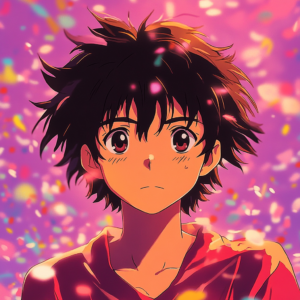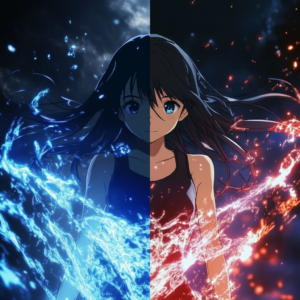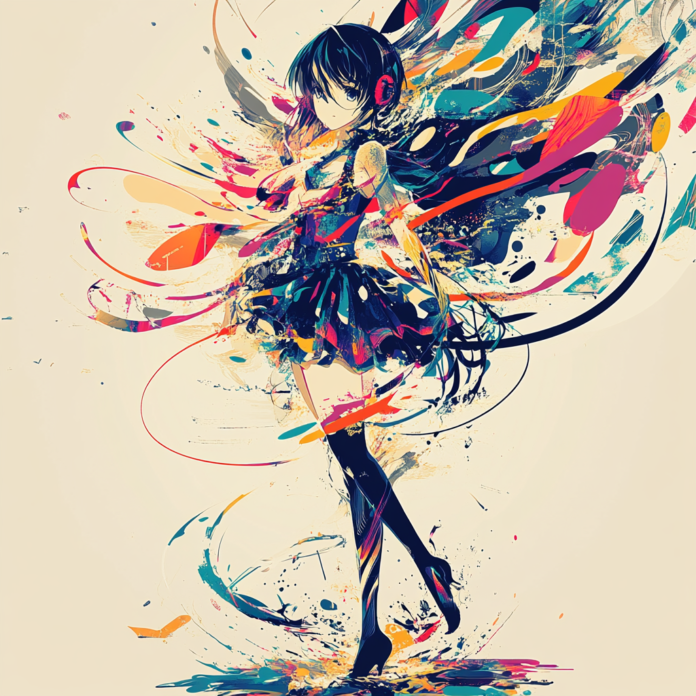1. Introduction
In today’s dynamic entertainment landscape, The Evolution of Anime Characters: Then and Now stands as a testament to the creative and technological progress that has shaped anime over the decades. As a passionate fan and content creator, I have closely followed this journey to bring you an in-depth review and analysis of how anime characters have transformed over time. This article delves into the history, cultural impact, and future trends of anime character development. The The Evolution of Anime will guide our discussion throughout this review. Join me as we explore the rich tapestry of character evolution that defines the anime world today.

Anime has not only been a source of entertainment but also a mirror reflecting societal changes and technological innovations. Over the decades, the way characters are conceived, designed, and developed has evolved tremendously. This article will examine each phase of this evolution and highlight pivotal moments that have redefined what it means to be an anime character.
2. Historical Background of Anime Character Development
The journey of anime character development began in the early decades of Japanese animation when simplistic designs and archetypal figures dominated the screen. In those formative years, characters were drawn with broad, expressive features and clear moral alignments that reflected the post-war societal context of Japan. These early works, often influenced by traditional art and theater such as Kabuki, established a foundation for visual storytelling that prioritized symbolic representation and emotional clarity.
During the 1950s and 1960s, pioneering studios like Toei Animation and Mushi Production introduced characters that were both iconic and accessible. These early characters, while visually simplistic, embodied the spirit and resilience of a society in transition. With limited technology, animators relied on hand-drawn frames and repetitive motion cycles; however, the charm of these works lay in their expressive simplicity and the strong storytelling that accompanied them.
As the medium matured through the 1970s and 1980s, anime began to experiment with more refined drawing techniques and richer color palettes. The introduction of cel animation allowed for more detailed and fluid movements, and as a result, characters started to exhibit subtle facial expressions and more dynamic poses. This period marked the beginning of a significant transformation: characters were no longer just symbols, but evolving entities with personality and depth.
The 1980s and 1990s were pivotal for the evolution of anime characters. This era saw the emergence of complex narratives and psychologically nuanced protagonists. Groundbreaking series such as “Mobile Suit Gundam” and “Neon Genesis Evangelion” redefined what an anime character could be. These series introduced multi-dimensional figures who struggled with internal conflicts, personal identity, and moral ambiguity. The transformation from simplistic, archetypal heroes to complex, layered personalities resonated with audiences globally and set a new benchmark for character storytelling in anime.
Moreover, the blending of traditional Japanese storytelling with Western narrative techniques during this period enriched the character development process. The incorporation of cinematic techniques, deeper dialogue, and complex plot structures helped forge characters that felt both universal and uniquely Japanese. This historical journey is essential for understanding the current state of anime character design and development.
3. Changing Character Archetypes
Over the decades, anime has witnessed a dramatic shift in character archetypes. Early anime frequently relied on clear-cut stereotypes such as the brave hero, the loyal sidekick, or the mysterious villain—each designed for quick audience recognition and moral clarity. These archetypes served as the building blocks for early storytelling, where the emphasis was on delivering a straightforward narrative with easily identifiable roles.
However, as storytelling in anime became more sophisticated, these archetypes were deconstructed and reimagined. Modern anime characters are rarely one-dimensional. They are crafted with layered personalities, complex backstories, and conflicting motivations that reflect the intricacies of real human behavior. The transformation in character archetypes mirrors the evolution of societal values and the audience’s growing desire for more realistic and relatable figures.
Today’s protagonists are often flawed individuals who face internal conflicts, struggle with ethical dilemmas, and experience significant personal growth over the course of the narrative. Their journeys are filled with moral ambiguity, making it difficult to categorize them simply as “good” or “evil.” Antagonists, too, are given depth; many modern villains have sympathetic qualities or understandable motivations, which challenge viewers to consider the nuances of right and wrong.
In addition, supporting characters have evolved from peripheral figures into vital components of the narrative. Side characters now often have their own arcs, contributing essential emotional and thematic depth. They offer diverse perspectives, enrich the storyline, and add complexity to the protagonist’s journey.
This evolution in character archetypes not only reflects advances in storytelling techniques but also represents a shift in audience expectations. Modern viewers demand multifaceted characters that mirror the complexities of real life. The evolution from rigid stereotypes to richly developed personalities is a cornerstone of contemporary anime and continues to drive the industry forward.
4. Advancements in Character Design and Animation
One of the most striking aspects of anime’s transformation is the advancement in character design and animation techniques. In the early days, the limitations of technology meant that characters were often rendered in a simplistic style, with basic shapes and minimal detail. As technology advanced, so did the sophistication of character designs.
Digital animation, computer-generated imagery (CGI), and advanced drawing tools have revolutionized how characters are created. Modern animators can now achieve a level of detail and fluidity that was once unimaginable. Every nuance—from subtle facial expressions to the intricate movement of hair and clothing—is meticulously crafted, contributing to a more lifelike and engaging portrayal of characters.
The evolution of digital techniques has also allowed for experimentation with textures, lighting, and perspective. This has led to the development of unique visual styles that blend traditional Japanese aesthetics with contemporary design elements. Many modern anime feature characters that are not only visually stunning but also imbued with personality and emotional depth.
Furthermore, advancements in animation technology have enabled the seamless integration of CGI with hand-drawn techniques. This hybrid approach enhances the overall visual impact, allowing for dynamic action sequences and immersive environments that support complex character interactions. For instance, techniques like motion capture and real-time rendering provide animators with the tools to produce highly detailed and realistic animations.
For those interested in the technical side of these innovations, this insightful video on YouTube from a renowned animation channel explains how digital tools have transformed character design and animation, greatly enhancing the storytelling process.
5. Cultural and Global Influences
The evolution of anime characters is not solely the result of technological advances; it is also deeply influenced by cultural and global factors. As anime expanded beyond Japan’s borders, it began to incorporate elements that resonated with international audiences, leading to a fusion of Eastern and Western narrative styles.
Globalization has brought diverse perspectives to anime storytelling, resulting in character designs that are more varied and relatable. Themes such as individuality, self-expression, and the struggle against societal expectations have become increasingly prominent in modern anime. This cultural synthesis has allowed anime to evolve into a medium that reflects both traditional Japanese values and contemporary global trends.
International collaborations have further enriched the creative process. For example, the Agency for Cultural Affairs of Japan provides official insights into Japan’s cultural heritage, which informs many modern anime productions. Similarly, the Japan Foundation offers resources on cultural exchange and the global impact of Japanese art forms. These sources highlight how traditional cultural values merge with modern influences to shape character development in anime.
The influence of global pop culture, social media, and fan communities has also played a significant role in character evolution. Fans from around the world contribute their own interpretations, create fan art, and engage in discussions that influence the direction of anime narratives. This interactive and collaborative process ensures that anime remains a vibrant and evolving art form, constantly adapting to new cultural contexts.
6. Impact of Technology on Anime Character Evolution
Technology has been a transformative force in shaping the evolution of anime characters. The transition from traditional hand-drawn animation to sophisticated digital techniques has redefined the boundaries of character creation. Modern software enables creators to experiment with motion, color, and texture with unprecedented precision. This allows for the creation of characters with lifelike expressions, intricate details, and dynamic movement that capture the subtle nuances of emotion.
Digital tools have opened up new avenues for artistic expression. Animators can now integrate advanced effects such as CGI, motion capture, and 3D modeling into their work. This fusion of techniques not only enhances the visual quality of anime but also enables more immersive storytelling. Every character is now rendered with a level of detail that makes them more relatable and emotionally engaging.
The digital revolution has also democratized the creative process, allowing independent artists to contribute fresh ideas and innovative designs. Online communities and digital platforms provide a space for collaboration, feedback, and the sharing of techniques, which further drives the evolution of anime. This continuous exchange of ideas has accelerated advancements in character design, ensuring that anime remains at the forefront of artistic innovation.
7. Future Trends and Predictions
Looking ahead, the future of anime character development promises even greater innovation. As technology continues to evolve, we can expect to see further improvements in animation quality and interactivity. Virtual reality (VR) and augmented reality (AR) are poised to revolutionize the way fans experience anime, offering immersive environments where viewers can interact with their favorite characters in real time.
Narrative trends indicate that future anime will delve deeper into psychological and philosophical themes. Characters will likely become even more complex, with narratives that explore the intricacies of human emotion and the interplay between fate and free will. The blending of genres—combining elements of science fiction, fantasy, and drama—will create rich, multifaceted stories that challenge traditional narrative structures.
Global influences will continue to shape anime, leading to more culturally diverse character portrayals. As international collaborations become more frequent, the exchange of artistic ideas will drive further innovation in character design and storytelling. This cross-cultural synergy will ensure that anime remains a dynamic and evolving medium, capable of resonating with audiences around the world.
Additionally, advancements in interactive technology will pave the way for new forms of storytelling. Imagine an anime where viewers can choose different narrative paths or interact with characters in real time—this level of engagement will redefine the relationship between audience and creator, making the evolution of anime even more exciting.
8. Monetization and Affiliate Opportunities
From a monetization standpoint, the evolving landscape of anime offers numerous opportunities for generating revenue. As anime continues to grow in popularity, the demand for merchandise, digital art, and exclusive collectibles increases. Strategic placement of Google AdSense throughout this article—positioned above the fold, mid-content, and at the conclusion—ensures maximum visibility while maintaining a seamless reading experience.
Affiliate marketing is also a significant revenue channel. By recommending related products such as limited-edition figures, art prints, and digital subscriptions, this article provides valuable insights to fans while creating multiple revenue streams.
Internal links to other relevant articles on MeadTavern.com—such as our in-depth discussions on Anime Character Development: Lessons from the Best and Anime Storytelling Techniques: Mastering the Art—further enhance user engagement and bolster SEO performance. These monetization strategies reflect modern digital marketing practices in the anime niche and ensure that the analysis of The Evolution of Anime is a valuable resource for both fans and marketers alike.

9. Frequently Asked Questions (FAQ)
Q1: What does “The Evolution of Anime Characters: Then and Now” refer to?
A: It refers to the transformation of anime character design and development from early, simplistic depictions to today’s complex, multi-dimensional portrayals that engage audiences on multiple levels.
Q2: How have character archetypes changed in anime over time?
A: Early anime featured clear-cut stereotypes, while modern anime presents characters with nuanced, layered personalities and conflicting motivations, reflecting significant progress in storytelling and character development.
Q3: What role has technology played in this evolution?
A: Technological advancements have enabled more detailed, fluid animation and innovative design techniques that bring anime characters to life with unprecedented realism and emotional depth.
Q4: How have cultural influences shaped anime characters?
A: Global cultural exchange has led to the integration of diverse elements, resulting in characters that blend traditional Japanese aesthetics with international storytelling techniques, resonating with audiences worldwide.
Q5: What future trends can we expect in anime character development?
A: Future trends include increased use of VR/AR for interactive experiences, deeper psychological portrayals, and greater integration of multicultural influences, ensuring continuous evolution and global appeal.

10. Conclusion
In conclusion, The Evolution of Anime Characters: Then and Now provides a comprehensive look at how anime has transformed from its early, simplistic beginnings into a medium celebrated for its richly developed and emotionally complex characters. This evolution is not merely about technological advancements—it is a cultural and artistic revolution that has redefined storytelling in anime. The journey from archetypal heroes to multifaceted protagonists encapsulates the dynamic progression of anime character design and development.
This article has examined the historical background, changing character archetypes, advancements in design and animation, and the global cultural influences that have shaped modern anime characters. As we look toward the future, emerging technologies and innovative storytelling promise even greater evolution, ensuring that the legacy of anime continues to grow and inspire new generations.
Thank you for reading this in-depth analysis. Stay tuned for more exclusive anime content and don’t forget to check out our affiliate recommendations to enhance your viewing experience. The journey of The Evolution of Anime is an ever-unfolding story with endless possibilities.
